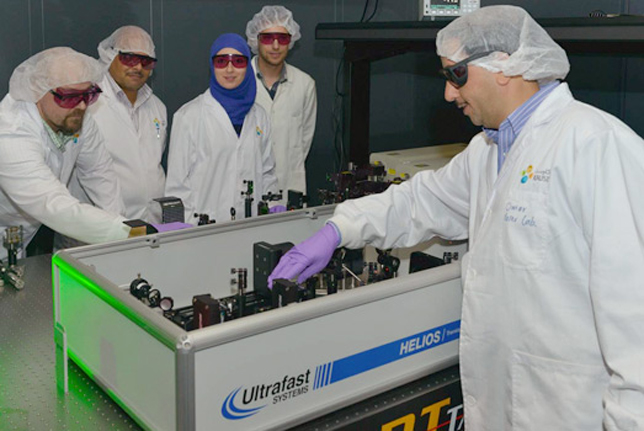Size makes a dramatic difference in tuning electron injection in quantum dot solar cells

Professor Omar F. Mohammed and his team.
Omar F. Mohammed, KAUST Assistant Professor of Chemical Science and the principal investigator of the ultrafast laser spectroscopy and four-dimensional electron imaging laboratory at KAUST's Solar and Photovoltaics Engineering Research Center, and a team of researchers from KAUST and the University of California at Berkeley recently published a paper in the Journal of the American Chemical Society (DOI: 10.1021/ja413254g) examining the properties essential for quantum dot (QD) solar cells.
QD solar cells are "emerging as promising low-cost alternatives to existing photovoltaic technologies," the researchers state. They are advantageous for use in photovoltaics for several reasons, including strong above-gap sunlight absorption, the possibility to tune the bandgap by controlling the QD size, solution processability, and the availability of a range of device architectures.
In solar cells, the efficient generation of current requires charge transfer (CT) at a donor-acceptor interface, but this must take place on a timescale much shorter than the lifetime of the excited state of the absorber. It has recently been shown that smaller-sized QDs, or QDs with increased bandgap energies, may promote, suppress, or rectify electron transfer to the accepting layer in the solar-cell device. QD size is also important in optimizing both charge transfer and separation at QD/oxide interfaces, which allows for the use of QDs instead of dyes in producing QD-sensitized solar cells.
In their work, the team used QDs and phenyl-C61-butyric acid methyl ester (PCBM) as a unique model system to examine the interfacial charge transfer and separation in real time using a combination of femtosecond (fs) broadband transient absorption (TA) spectroscopy and steady-state photoluminescence quenching measurements.
"We added a piece to the puzzle into how we can tune electron injection at the interface between QDs and PCBM, which is a material commonly used in solar cells," says Prof. Mohammed. "The steady-state and femtosecond time-resolved data clearly demonstrate that the charge transfer process at the QDs-PCBM interface can be tuned from zero to very efficient and ultrafast injection by controlling the size of the QDs."
The researchers investigated charge separation and ultrafast electron injection at the QD/PCBM interfaces for four different sizes of QDs, and also as a function of PCBM concentration. They claimed that the energy band alignment is one of the key elements for efficient electron injection and charge separation processes. "More specifically," the researchers state, "the steady-state and time-resolved data demonstrate that only small-sized QDs with a bandgap larger than 1 electron volt can transfer electrons to PCBM upon light absorption."
"For QD solar cells, size makes all the difference," Prof. Mohammed says. "Our results have clearly demonstrated for the first time the possibility of modulating the electron transfer rate between QDs and PCBM by tailoring the size distribution of QDs via quantum confinement effects."
Prof. Mohammed hopes the team's work will advance the understanding and design of QD interfaces for solar energy conversion. "We hope our work enables other researchers to understand that the size of QDs can make a dramatic difference, and that it should be taken into consideration before the fabrication of QD solar cell devices," he says.

